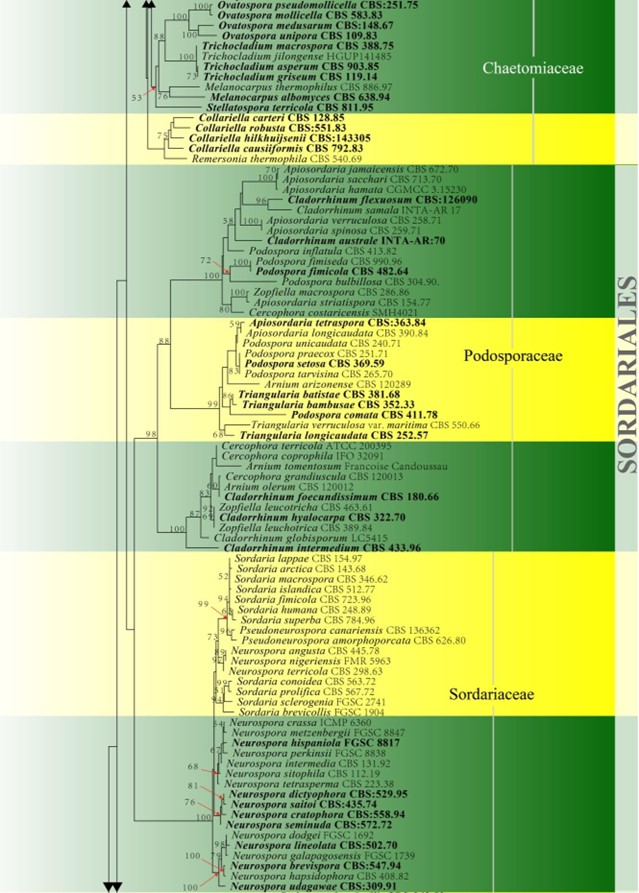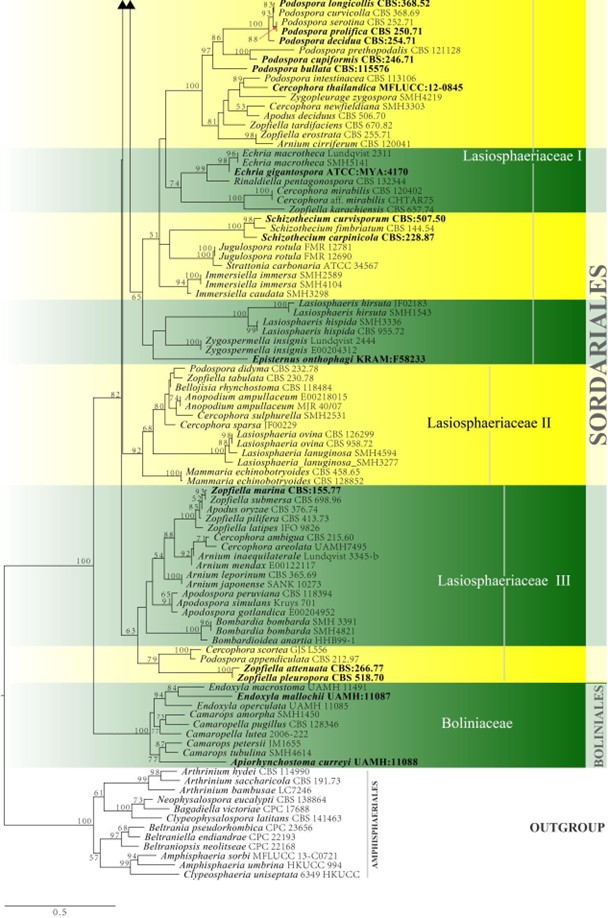Sordariales Chadef. ex D. Hawksw. & O.E. Erikss., Syst. Ascom. 5(1): 182 (1986)
Index Fungorum number: IF 90499; MycoBank number: MB 90499; Facesoffungi number: FoF 01148;
Sordariales was established by Hawksworth & Eriksson (1986) and clarified by Huhndorf et al. (2004b) based on LSU sequences analysis. Chaetomiaceae, Sordariaceae and Lasiosphaeriaceae are accommodated in this order and taxa are characterized by cleistothecial or perithecial ascomata and hyaline or brown ascospores often with appendages or sheaths (Huhndorf et al. 2004b, Kruys et al. 2015, Maharachchikumbura et al. 2016b, Huang et al. 2019). Sordariales members cluster in a clade with Boliniales, Chaetosphaeriales and Phyllachorales (Hongsanan et al. 2017, Hyde et al. 2017a). The traditionally defined Chaetomiaceae and Lasiosphaeriaceae were found to be polyphyletic (Huhndorf et al. 2004b, Kruys et al. 2015, Wang et al. 2016a). Some members of Lasiosphaeriaceae, Triangularia, Cladorrhinum and Podospora, were placed in a new family Podosporaceae (Wang et al. 2019a). In this study, Chaetomiaceae, Podosporaceae, Lasiosphaeriaceae (I, II, III), and Sordariaceae form a distinct lineage (Fig. 23). However, more data is needed to determine the phylogenetic affinities of this order. The divergence time for Sordariales is estimated as 128 MYA (Fig. 2). Currently there are four families and 89 genera in this order (this paper).

Figure 2 – The maximum clade credibility (MCC) tree, using the same dataset from Fig. 1. This analysis was performed in BEAST v1.10.2. The crown age of Sordariomycetes was set with Normal distribution, mean = 250, SD = 30, with 97.5% of CI = 308.8 MYA, and crown age of Dothideomycetes with Normal distribution mean = 360, SD = 20, with 97.5% of CI = 399 MYA. The substitution models were selected based on jModeltest2.1.1; GTR+I+G for LSU, rpb2 and SSU, and TrN+I+G for tef1 (the model TrN is not available in BEAUti 1.10.2, thus we used TN93). Lognormal distribution of rates was used during the analyses with uncorrelated relaxed clock model. The Yule process tree prior was used to model the speciation of nodes in the topology with a randomly generated starting tree. The analyses were performed for 100 million generations, with sampling parameters every 10000 generations. The effective sample sizes were checked in Tracer v.1.6 and the acceptable values are higher than 200. The first 20% representing the burn-in phase were discarded and the remaining trees were combined in LogCombiner 1.10.2., summarized data and estimated in TreeAnnotator 1.10.2. Bars correspond to the 95% highest posterior density (HPD) intervals. The scale axis shows divergence times as millions of years ago (MYA).

Figure 2 – Continued.

Figure 2 – Continued.

Figure 23 – Phylogram generated from maximum likelihood analysis based on combined LSU, ITS, tub2 and rpb2 sequence data of Sordariales. Related sequences were taken from Wang et al. (2016b). Two hundred and fifty-seven strains are included in the combined analyses which comprised 2717 characters (855 characters for LSU, 480 characters for ITS, 860 characters for tub2, 522 characters for rpb2) after alignment. Members of Amphisphaeriales are used as outgroup taxa. Single gene analyses were carried out and the phylogenies were similar in topology and clade stability. The best RAxML tree with a final likelihood value of -59082.079074 is presented. Estimated base frequencies were as follows: A = 0.238795, C = 0.266829, G = 0.275292, T = 0.219085; substitution rates AC = 1.483472, AG = 3.436969, AT = 1.859704, CG = 1.064423, CT = 6.934931, GT = 1.000000; gamma distribution shape parameter a = 0.757314. Bootstrap support values for ML greater than 50% are given near the nodes. Ex-type strains are in bold. The newly generated sequences are indicated in blue.

Figure 23 – Continued.

Figure 23 – Continued.
Families
Sordariales genera incertae sedis
